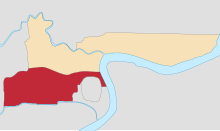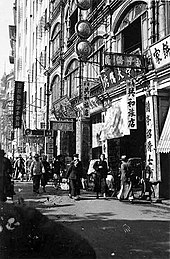
Luwan District was a district located in central Shanghai, until its merger with Huangpu District in June 2011. It had an area of 8.05 km2 (3.11 sq mi) and population of 350,000 as of 2001.
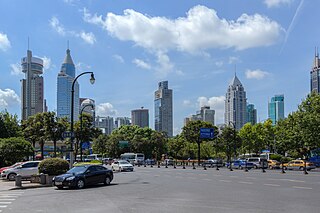
Huangpu District, makes up the eastern part of Shanghai's traditional urban core and is today the most central of Shanghai's 16 districts. Huangpu district is the seat of municipal government, includes key attractions such as The Bund and the Old City God Temple, as well as popular shopping districts such as Nanjing Road, Huaihai Road, and Xintiandi. The Huangpu District is one of the most densely populated urban districts in the world.

The Bund is a waterfront area and a protected historical district in central Shanghai. The area centers on a section of Zhongshan Road within the former Shanghai International Settlement, which runs along the western bank of the Huangpu River in the eastern part of Huangpu. The area along the river faces the modern skyscrapers of Lujiazui in Pudong. The Bund usually refers to the buildings and wharves on this section of the road, as well as some adjacent areas. This region has a significant European influence, with the style of many structures most comparable to that of European cities, particularly Gothic, Baroque, Neoclassical, Romanesque, Art Deco, and Renaissance architecture. Additionally, some of the city's top eateries are located there. From the 1860s to the 1930s, it was the rich and powerful center of the foreign establishment in Shanghai, operating as a legally protected treaty port.

Xujiahui is a locality in Shanghai. It is a historic area of commerce and culture administratively within Xuhui District, which is named after the locality. The area is a well-known precinct for shopping and entertainment in Shanghai. It is served by the Xujiahui Station of the Shanghai Metro.

Xuhui District is a core urban district of Shanghai. It has a land area of 54.76 km2 (21.14 sq mi) and a population of 1,113,078 as of 2020. Xuhui District has 12 subdistricts and two townships.

Puxi is the historic center of Shanghai, China, and remains the home of approximately 48% of Shanghai's residents in an area of 288 km2. Puxi is distinguished from Pudong to its east, which is separated from it by the Huangpu River. Despite the growing importance of Pudong's Lujiazui area, Puxi remains Shanghai's cultural, residential and commercial center.

The Shanghai International Settlement originated from the merger in the year 1863 of the British and American enclaves in Shanghai, in which British and American citizens would enjoy extraterritoriality and consular jurisdiction under the terms of unequal treaties agreed by both parties. These treaties were abrogated in 1943.

Hengshan Road, formerly Avenue Pétain, is a street in the former French Concession of Shanghai, China. A major thoroughfare that connected the heart of the French Concession with the Catholic district of Zikawei (Xujiahui), the boulevard was for much of the 20th century the centre of Shanghai's premier residential district. Since the 1990s, many of the mansions along the road have been converted into bars, night clubs, and restaurants. From 2016 onward, many of the bars on Hengshan Road have been closed down or moved away to other new and more popular entertainment districts in the city.

The history of Shanghai spans over a thousand years and closely parallels the development of modern China. Originally a small agricultural village, Shanghai developed during the late Qing dynasty (1644–1912) as one of China's principal trading ports. Although nominally part of China, in practice foreign diplomats controlled the city under the policy of extraterritoriality. Since the economic reforms of the early 1990s the city has burgeoned to become one of Asia's major financial centers and the world's busiest container port.
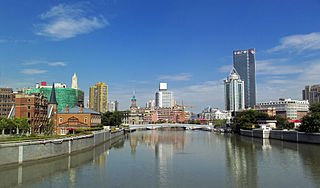
Suzhou Creek, also called the Wusong (Woosung) River, is a river that passes through the Shanghai city center. It is named after the neighboring city of Suzhou (Soochow), Jiangsu, the predominant settlement in this area prior to the rise of Shanghai as a metropolis.

Tianzifang or Tianzi Fang is a touristic arts and crafts enclave that has developed from a renovated traditional residential area in the French Concession area of Shanghai. It is now home to boutique shops, bars and restaurants.
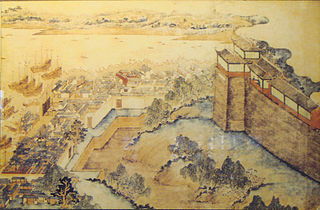
The Old City of Shanghai, also formerly known as the Chinese city, is the traditional urban core of Shanghai. Its boundary was formerly defined by a defensive wall. The Old City was the county seat for the old county of Shanghai. With the advent of foreign concessions in Shanghai, the Old City became just one part of Shanghai's urban core, but continued for decades to be the seat of the Chinese authority in Shanghai. Notable features include the City God Temple, which is located in the center of the Old City and is connected to the Yuyuan Garden. With the exception of two short sections, the walls were demolished in 1912, and a broad circular avenue built over the former wall and moat: the southern half was named the "Zhonghua Road" and the northern half the "Minguo Road".

Huaihai Road or Huaihai Lu is a road in Shanghai, China. The central section of Huaihai Road is one of the two major shopping streets in central Shanghai; the other is Nanjing Road. Compared with the more touristy Nanjing Road, Huaihai Road is more upscale, and is the preferred destination of local residents. Huaihai Road comprises three sections, the main section being Middle Huaihai Road in the former French Concession of Shanghai. Middle Huaihai Road is also well known by its former French name Avenue Joffre. Huaihai Road East was in the original French Concession and was formerly known as Rue Ningpo (寧波路), while Huaihai Road West was an extra-settlement road built by the Shanghai International Settlement and formerly known as Jordan Road (喬敦路)

Shanghai County was a Chinese county in modern-day Shanghai Municipality. Shanghai County was first established in 1292 and finally abolished in 1992. Shanghai County was for most of its existence a part of Songjiang Prefecture, in Jiangsu Province, but later became a county under Shanghai Municipality. Shanghai County was historically the governing authority of the Shanghai's urban area and neighbouring areas. Its extent reduced with the establishment of the Shanghai Special Municipality and, later, Shanghai Municipality. Immediately before abolition, the county extended over a crescent-shaped area adjacent to, and surrounding, the southwest of Shanghai's city centre.

Yan'an Road is a road in Shanghai, a major east–west thoroughfare through the centre of the city. The modern Yan'an Road is in three sections, reflecting three connected streets which existed pre-1945: Avenue Edward VII, Avenue Foch, and the Great Western Road. The streets were joined together under a common name by the Republic of China government in 1945, then renamed in the early 1950s after the Chinese Communist Party took over Shanghai. The road is named after Yan'an, the Communist base during the Chinese Civil War.

The Consulate General of the United States in Shanghai is one of the five American diplomatic and consular posts in the People's Republic of China.

The Wukang Mansion or Wukang Building, formerly known as the Normandie Apartments or International Savings Society Apartments, is a protected historic apartment building in the former French Concession area of Shanghai. It was designed by the Hungarian-Slovak architect László Hudec and completed in 1924. The building has been the residence of many celebrities.

The Shanghai Library Bibliotheca Zi-Ka-Wei, also known as the Bibliotheque de Mission, is the first modern library to be established in Shanghai, China. Located in the Xujiahui area in Xuhui District, it first opened in 1847. It is a part of the Shanghai Library system.

The extra-settlement roads in Shanghai were roads constructed by the Shanghai International Settlement, a foreign concession in Shanghai, beyond its formal boundaries. The Settlement authorities obtained a certain degree of administrative authority over the extra-settlement roads and neighbouring areas, so that the extra-settlement roads area were regarded as a "quasi-concession" area attached to the concession area proper. The Settlement authorities had police powers alongside specific roads within the extra-settlement roads area, and had the power to levy rates or taxes in relation to services relating to the roads, but other administrative powers relating to the area remained with the Chinese government.
